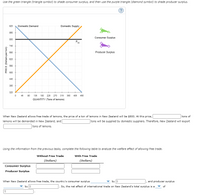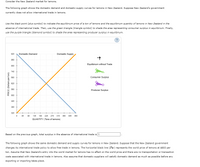
ENGR.ECONOMIC ANALYSIS
14th Edition
ISBN: 9780190931919
Author: NEWNAN
Publisher: Oxford University Press
expand_more
expand_more
format_list_bulleted
Question
thumb_up100%

Transcribed Image Text:Use the green triangle (triangle symbol) to shade consumer surplus, and then use the purple triangle (diamond symbol) to shade producer surplus.
920
Domestic Demand
Domestic Supply
860
Consumer Surplus
800
Pw
740
680
Producer Surplus
620
580
500
440
380
320
45
90
135
180
225
270
315
360
405
450
QUANTITY (Tons of lemons)
When New Zealand allows free trade of lemons, the price of a ton of lemons in New Zealand will be $800. At this price, |
tons of
lemons will be demanded in New Zealand, and
|tons will be supplied by domestic suppliers. Therefore, New Zealand will export
tons of lemons.
Using the information from the previous tasks, complete the following table to analyze the welfare effect of allowing free trade.
Without Free Trade
With Free Trade
(Dollars)
(Dollars)
Consumer Surplus
Producer Surplus
When New Zealand allows free trade, the country's consumer surplus
by $
and producer surplus
by S
. So, the net effect of international trade on New Zealand's total surplus is a
of
PRICE (Dollars per ton)

Transcribed Image Text:Consider the New Zealand market for lemons.
The following graph shows the domestic demand and domestic supply curves for lemons in New Zealand. Suppose New Zealand's government
currently does not allow international trade in lemons.
Use the black point (plus symbol) to indicate the equilibrium price of a ton of lemons and the equilibrium quantity of lemons in New Zealand in the
absence of international trade. Then, use the green triangle (triangle symbol) to shade the area representing consumer surplus in equilibrium. Finally,
use the purple triangle (diamond symbol) to shade the area representing producer surplus in equilibrium.
(?
920
Domestic Demand
Domestic Supply
860
Equilibrium without Trade
800
740
680
Consumer Surplus
820
580
Producer Surplus
500
440
380
320
45
90
135
180
225
270
315
380 405
450
QUANTITY (Tons of lemons)
Based on the previous graph, total surplus in the absence of international trade is S
The following graph shows the same domestic demand and supply curves for lemons in New Zealand. Suppose that the New Zealand government
changes its international trade policy to allow free trade in lemons. The horizontal black line (Pw) represents the world price of lemons at $800 per
ton. Assume that New Zealand's entry into the world market for lemons has no effect on the world price and there are no transportation or transaction
costs associated with international trade in lemons. Also assume that domestic suppliers will satisfy domestic demand as much as possible before any
exporting or importing takes place.
PRICE (Dollars per ton)
Expert Solution
This question has been solved!
Explore an expertly crafted, step-by-step solution for a thorough understanding of key concepts.
This is a popular solution
Trending nowThis is a popular solution!
Step by stepSolved in 3 steps with 1 images

Knowledge Booster
Learn more about
Need a deep-dive on the concept behind this application? Look no further. Learn more about this topic, economics and related others by exploring similar questions and additional content below.Similar questions
- Consider the market for coffee in the small, isolated country of Krakozhia. Within Krakozhia, the domestic demand for coffee is: Q = 500-2p and the domestic supply of coffee is: Q* = -150+ 3parrow_forwardRefer to the information in the followina table and answer questions 15 to 18. Quantity demanded domestically 15000 Price Quantity supplied domestically $ 20 20000 17500 20000 22500 25000 17 14 11 8 17500 15000 12500 10000 15 If the market were closed to the international trade, the revenue earned by the domestic producers will be:... 16 If the market was open to international trade and the world price was $11, total revenue of the international trade will be:...... 17 Assume world price $14 includes a tariff of $3 per product. Net revenue of the foreign suppliers after tariff will be:.. 18 At the world price $11 which includes tariff of $3 per product, quota of 10000 imported items will enable the government to get $30000 as tariff revenue if tariff duty is abolished. Do you agree? Why?arrow_forwardAssuming the market outcome, and a world price of $6.50 calculate the following: Price Qddom Qsdom Imports or exportsarrow_forward
- 3:55 PM Tue Apr 27 * 40% D ( Notes April 27, 2021 at 3:54 PM When China's supply of clothing increases, the increase in world supply lowers the world price of clothing. -Draw an appropriate diagram to analyze how this change in the world price affects consumer surplus, producer surplus, and total surplus in a nation that imports clothing, such as the US. (1)Label the old and new world prices(2)The change in quantity demanded my customers, and (3) The change in quantity supplied by domestic producers. Make a table that shows consumer surplus, producer surplus, and total surplus at the old world price and New World price.arrow_forwardTyped plz and asap thanksarrow_forward00 7 F. PRICE (Dollars per ton) 4. Effects of a tariff on international trade The following graph shows the domestic supply of and demand for soybeans in Honduras. The world price (Pw) of soybeans is $530 per ton and is represented by the horizontal black line. Throughout the question, assume that the amount demanded by any one country does not affect the world price of soybeans and that there are no transportation or transaction costs associated with international trade in soybeans. Also, assume that domestic suppliers will satisfy domestic demand as much as possible before any exporting or importing takes place. 2. Domestic Demand Domestic Supply 770 740 710 680 650 620 06 P, 530 MacBook Pro Search or type URL 4. 51 9.arrow_forward
- The figure provided shows the Canadian domestic market for calculators. Price of calculators $450 40 30 20 25 10 S world price with tariff world price Fore 50 100 200 300 400 500 600 700 800 900 Quantity of calculators If the world price is $5 and an import quota of 600 is imposed, the price after the quota, in numerals, isarrow_forward4. Effects of a tariff on international trade The following graph shows the domestic supply of and demand for wheat in New Zealand. The world price (Pw) of wheat is $255 per bushel and is represented by the horizontal black line. Throughout the question, assume that the amount demanded by any one country does not affect the world price of wheat and that there are no transportation or transaction costs associated with international trade in wheat. Also, assume that domestic suppliers will satisfy domestic demand as much as possible before any exporting or importing takes place. PRICE (Dollars per bushel) 480 Domestic Demand 455 430 405 380 355 330 305 280 255 230 0 " 30 Domestic Supply 60 90 120 150 180 210 QUANTITY (Bushels of wheat) ++ PW 240 270 300 ?arrow_forwardI have no idea what the answer is.arrow_forward
- Typed and correct answer please. I will rate accordingly. Please don't do wrong..arrow_forwardPRICE (Dollars per tonne) 800 Domestic Demand 750 700 650 600 550 500 450 400 350 300 0 Domestic Supply 40 80 120 160 200 240 280 320 360 400 QUANTITY (Thousands of tonnes of tangerines) No Trade Equilibrium A Consumer Surplus ◇ Producer Surplus Based on the previous graph, total surplus in the absence of international trade is the graph.) $25 million. (Hint: Take note of the units on the axes of The following graph shows the same domestic demand and supply curves for tangerines in Guatemala presented in the previous graph. Suppose that the Guatemalan government changes its international trade policy to allow free trade in tangerines. The horizontal black line (Pw) represents the world price of tangerines at $500 per tonne. Assume that Guatemala's entry into the world market for tangerines has no effect on the world price and that there are no transportation or transaction costs associated with international trade in tangerines. Also assume that domestic suppliers will satisfy domestic…arrow_forwardFigure: Tariffs Price $90 88 150 O $90; 1,150 O $60; 650 O $60, 1,150 O $40; 1,800 Domestic spply World supply tarif 1150 1550 1800 In the domestic market with international trade and no tariffs, the price is Domenic demand Quantity and the quantity purchased in the United States is units.arrow_forward
arrow_back_ios
SEE MORE QUESTIONS
arrow_forward_ios
Recommended textbooks for you

 Principles of Economics (12th Edition)EconomicsISBN:9780134078779Author:Karl E. Case, Ray C. Fair, Sharon E. OsterPublisher:PEARSON
Principles of Economics (12th Edition)EconomicsISBN:9780134078779Author:Karl E. Case, Ray C. Fair, Sharon E. OsterPublisher:PEARSON Engineering Economy (17th Edition)EconomicsISBN:9780134870069Author:William G. Sullivan, Elin M. Wicks, C. Patrick KoellingPublisher:PEARSON
Engineering Economy (17th Edition)EconomicsISBN:9780134870069Author:William G. Sullivan, Elin M. Wicks, C. Patrick KoellingPublisher:PEARSON Principles of Economics (MindTap Course List)EconomicsISBN:9781305585126Author:N. Gregory MankiwPublisher:Cengage Learning
Principles of Economics (MindTap Course List)EconomicsISBN:9781305585126Author:N. Gregory MankiwPublisher:Cengage Learning Managerial Economics: A Problem Solving ApproachEconomicsISBN:9781337106665Author:Luke M. Froeb, Brian T. McCann, Michael R. Ward, Mike ShorPublisher:Cengage Learning
Managerial Economics: A Problem Solving ApproachEconomicsISBN:9781337106665Author:Luke M. Froeb, Brian T. McCann, Michael R. Ward, Mike ShorPublisher:Cengage Learning Managerial Economics & Business Strategy (Mcgraw-...EconomicsISBN:9781259290619Author:Michael Baye, Jeff PrincePublisher:McGraw-Hill Education
Managerial Economics & Business Strategy (Mcgraw-...EconomicsISBN:9781259290619Author:Michael Baye, Jeff PrincePublisher:McGraw-Hill Education


Principles of Economics (12th Edition)
Economics
ISBN:9780134078779
Author:Karl E. Case, Ray C. Fair, Sharon E. Oster
Publisher:PEARSON

Engineering Economy (17th Edition)
Economics
ISBN:9780134870069
Author:William G. Sullivan, Elin M. Wicks, C. Patrick Koelling
Publisher:PEARSON

Principles of Economics (MindTap Course List)
Economics
ISBN:9781305585126
Author:N. Gregory Mankiw
Publisher:Cengage Learning

Managerial Economics: A Problem Solving Approach
Economics
ISBN:9781337106665
Author:Luke M. Froeb, Brian T. McCann, Michael R. Ward, Mike Shor
Publisher:Cengage Learning

Managerial Economics & Business Strategy (Mcgraw-...
Economics
ISBN:9781259290619
Author:Michael Baye, Jeff Prince
Publisher:McGraw-Hill Education